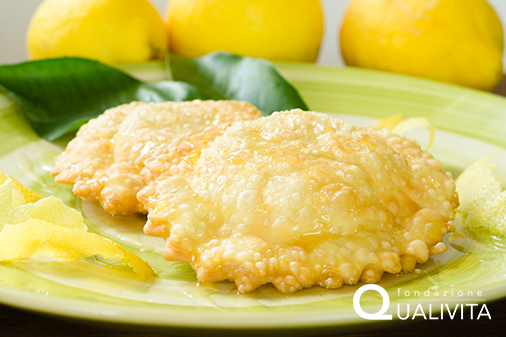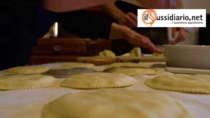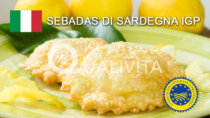Description
Sebadas di Sardegna PGI or Seadas/Sabadas/Seattas/Savadas/Sevadas di Sardegna PGI are stuffed fresh pastry products, the pastry of which is made of Durum wheat semolina and/or re-ground Durum wheat flour and/or soft wheat flour, with the possible addition of lard and/or egg yolk; the filling is made by mixing pecorino cheese and/or goat’s cheese and/or cow’s cheese or cow's rennet with grated lemon and/or orange peel, to which sugar can be added as desired.
Production Area
The production area of Sebadas di Sardegna PGI is within the entire territory of the Sardinia region.
Production Method
The preparation of Sebadas di Sardegna PGI involves the production of fresh pastry and the filling. The fresh pastry or puff pastry is made by mixing the ingredients either by hand or with a mechanical kneader; the dough is rolled out with a rolling pin or rolling machine and then cut and divided between the moulds. The filling can be prepared according to two different procedures: "raw" or by "cooking". The "raw" filling is made by mixing the ingredients with orange and/or lemon peel, with the possible addition of sugar; “cooking" the filling involves melting all the cheese or curd and adding the citrus peel and sugar if required. The raw or cooked filling is then placed inside two sheets of pastry which have been cut into the typical round or oval shape. Packaging must take place within the production area to limit the amount of manipulation and preserve the quality of the finished product.
Appearance and Flavour
Sebadas di Sardegna PGI are round or oval with wavy or smooth edges and have two layers of pastry; each layer of pastry is 0.5 mm to 3 mm thick, with a diameter ranging from 40 mm to 180 mm. The weight of each Sebadas varies from a minimum of 30 g to a maximum of 300 g. The consistency of the fresh product is soft, with a homogeneous filling, while the colour of the pastry ranges from ivory white to straw-yellow. It has sour, aromatic taste, of varying intensity depending on the mixture of cheeses, with hints of citrus fruit and a sweet-salty contrast. The colour of the filling ranges from white to straw-yellow, with possible yellow or orange streaks due to the lemon or orange peel.
History
The origins of Sebadas can be attributed to the agri-pastoral traditions which have characterised Sardinia over the centuries. Sardinian agriculture is still based on sheep, pig and cereal farming, from which the main ingredients of the product are derived. In the past, Sebadas were served to welcome back shepherds from the annual migration and thank them for the work they had done. In 1894, the famous writer Grazia Deledda defined Sebadas as small, deep-fried pastry and cheese flatbreads cooked over fire, in her book Tradizioni popolari di Nuoro.
Gastronomy
Sebadas di Sardegna PGI are traditionally eaten deep-fried, sprinkled with honey or sugar, and served warm. Despite being considered a stuffed pasta, they are served as a dessert and paired with wines like Moscato di Sardegna PDO Passito or dry white wines such as Vermentino di Sardegna PDO.
Marketing
The product is marketed as Sebadas di Sardegna PGI or Seadas/Sabadas/Seattas/Savadas/Sevadas di Sardegna PGI all year round. It can be sold fresh, frozen or packaged in a protected atmosphere. The product can only be sold loose when fresh. The label may also display the wording ‘prodotto secondo l’antica ricetta della fusione del ripieno’ (produced in accordance with the old melted filling recipe) if the filling is made with the “cooked” method. The reference to ‘Sebadas/Seadas/Sabadas/Seattas/Savadas/Sevadas di Sardegna PGI may also be used for the product produced in restaurants within the production area.
Distinctive Features
The flavour of Sebadas di Sardegna PGI is characterised by the sour taste of the cheese in the filling, combined with the aromas of orange and lemon, creating a pleasant contrast with the honey, which is traditionally drizzled on the cooked product.











